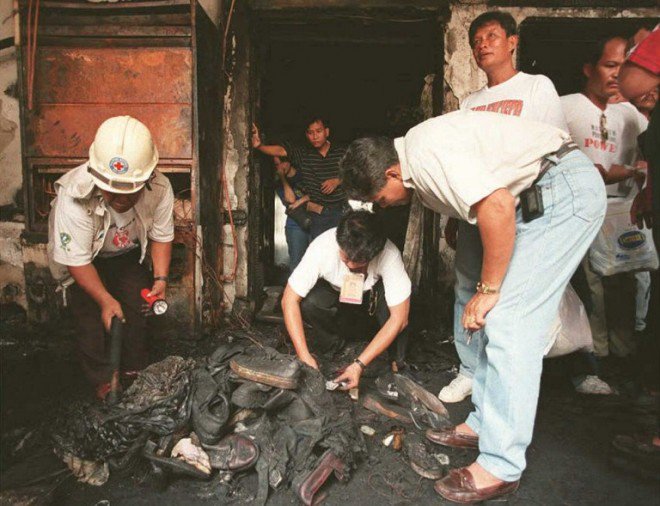It was around the ‘80s to mid-1990s when discotheque became a thing in the Philippines. Wherever you looked, you’d see a multitude of nightclubs lining the busy streets of Manila, Makati, and Quezon City, which only tells us that Filipinos have always loved the nightlife. Quezon City, in particular, has a long list of late-night entertainment options—and one of these was the now-infamous Ozone Disco where the country’s worst fire incident occurred.
In a report published by INQUIRER.net, the Ozone Disco tragedy claimed the lives of at least 162 people while 93 others were severely injured. Unfortunately, most of them were students who at the time were celebrating the end of the school year.
Before the tragedy
Back then, students and even professionals would frequent Ozone Disco (no matter what day it was) just to have a good time after a grueling work schedule. And for disco-goers, going there on a Monday night (March 18, 1996) was definitely the perfect time to have a drink since the club was also offering a 50% discount promo for guests. But what was supposed to be a night of revelry turned out to be the Philippines’ worst fire incident and the seventh worst fire incident in the world.

According to multiple sources, it all started with just a single spark on the ceiling above the disc jockey’s booth, but no one acted upon it as people thought it was just some sort of the club’s special effects. Then a fire broke out which immediately swallowed the entire place. Everyone jostled against each other, struggling to get through the door. However, getting out became harder as the door could only be opened inwards. And during that time, there were 300 guests when the club could only hold about a hundred.
While some suffered from second and third-degree burns all over their body, others didn’t survive at all.
Ozone Disco Club was a “firetrap”
In the Philippines, the month of March is being observed as Fire Prevention Month by virtue of Presidential Proclamation No. 115-A due to the alarming increase of fire incidents happening across the country during this particular period.
Apparently, the Ozone Disco tragedy was one of the numerous fire catastrophes that happened in the past. Investigators who looked into the case described Ozone Disco Club as a “firetrap” because it lacked exit routes, fire extinguishers, and warning devices.
Ozone Disco was owned by Hermilo Ocampo, president, and Ramon Ng, treasurer of Westwood Entertainment. According to the National Building Code of the Philippines, “there shall be at least one entrance and another one for exit.” But during the investigation, the disco only had a swing-in door—which served as the entrance and exit door. In 2014, INQUIRER.net published a report stating that according to the court, “the fire showed that the building officials in conspiracy with the others accused ignored the provisions of the National Building Code.”
The court then added that “The supposed alternative exit, which was located at the VIP lounge, was actually obstructed by a sofa and an LPG (liquefied petroleum gas) tank, which only led to a firewall.” It was also found that Ocampo and Ng worked together to secure “unwarranted benefits, advantage or preference” from the former building officials.
“The audacity of Westwood… in the construction of Ozone Disco Club by evading compliance with important provisions of the National Building Code to suit its own business purposes is simply overwhelming,” the court said.
“There can never be a slapdash approval of a building permit and certificate of occupancy. To [shirk] from this duty will certainly run at risk all safety standards contemplated by the National Building Code,” it added.
An obvious violation of the National Building Code, the court also mentioned that “Had the violations been averted at the first instance, the magnitude of those who died and those who continue to endure scars that would haunt them for life, would not have happened.”
The verdict
It was only in November 2014 when the Sandiganbayan finally sentenced the city personnel and businessmen to 6-10 years in prison for the Ozone Disco inferno. Former Quezon City engineer Alfredo Macapugay and six members of his staff—Donato Rivera Jr., Edgardo Reyes, Francisco Itliong, Feliciano Sagana, Petronillo de Llamas and Rolando Mamaid—were also found guilty beyond reasonable doubt by the Sandiganbayan Fifth Division for violation of Republic Act No. 3019, or the Anti-Graft and Corrupt Practices Act.
Ocampo and Ng, stockholders of Westwood Entertainment Co. Inc. and operators of the dance club would also face the same consequence.
Remembering the tragedy
Fast forward to 2016, the spot where Ozone Disco used to be is now a food chain co-owned by TV host Boy Abunda. Known for its tagline, “Open 25 hours a day,” GoodAh!!! serves silog meals and other Filipino dishes such as pares, pork sinigang, nilaga, and bistek. Last year, Unique Salonga, formerly the frontman of disco-pop band IV of Spades, released his first solo debut album titled “Grandma.” The album consists of 12 tracks—one of which is called OZONE (Itulak ang Pinto), a song which draws inspiration from the 1996 Ozone Disco tragedy.
While some establishment owners can still get away with violations of building code, there are at least little improvements in terms of building safety compliant. It has been 23 years since the tragedy happened, but the devastating memories are still etched on the minds of those who survived.
____
Read more from InqPOP!:
The eternal flame of Philippine motels
The Lost Art of Cross-Stitching
The dark origins of Valentine’s Day and how it became the celebration of love we know today


